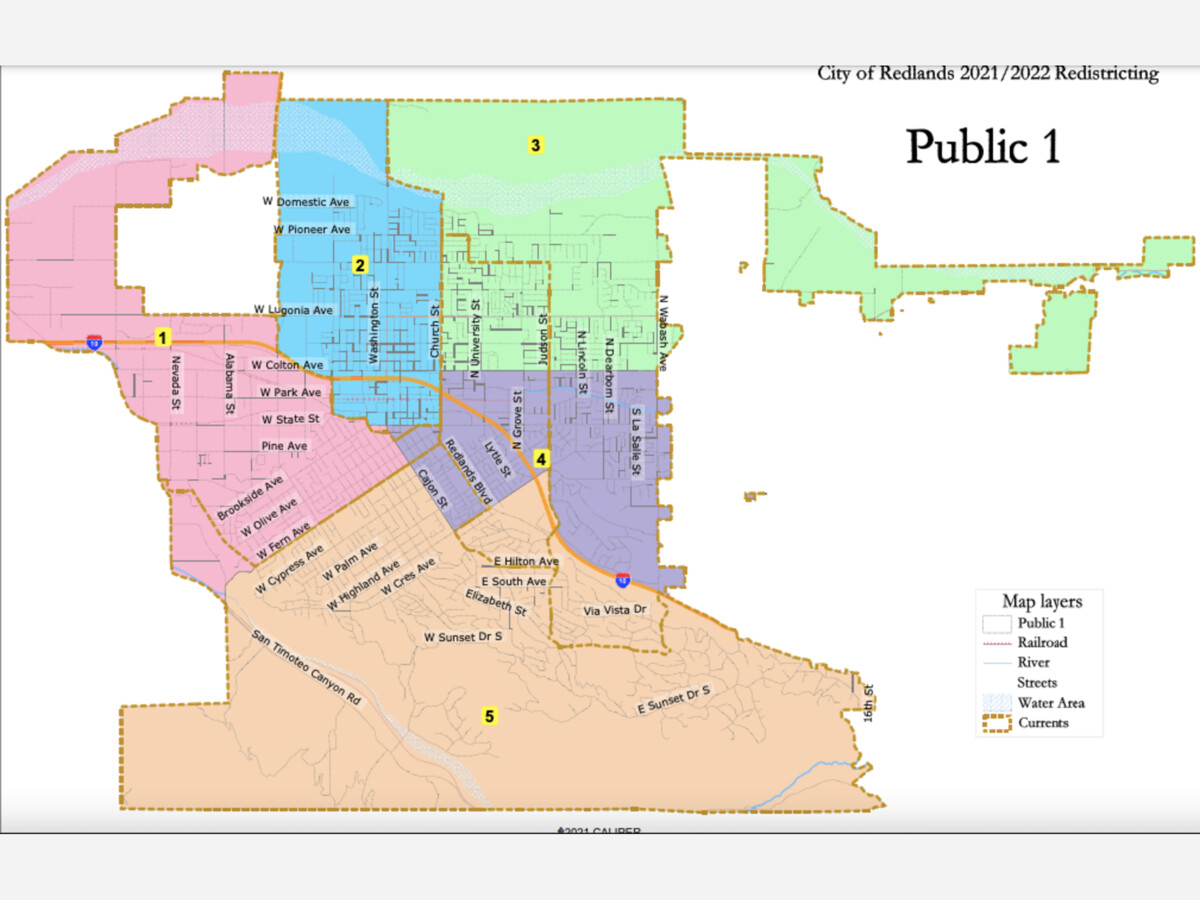Image

On March 1, the Redlands City Council unanimously approved Public Map 1, which advocates say provides more equity for historically underrepresented neighborhoods of interest. The vote took place after a charged discussion and a failed motion to keep districts as is.
Michael Tamony, one of the citizens who helped create Map 1, spoke during the public comment segment of the meeting, saying the map was "designed to do no harm, to keep neighborhoods whole and respect communities of interest."
Lorraine Enriquez agreed, saying map 1 remedies the imbalance of power which has historically favored the South Side of the city.
Brian Seghers said he preferred 1B, and said in addition to more equitable districts, candidates should not accept contributions from outside of their district.
Two residents of district 1, Shan Garcia and Shawn M., expressed a preference for map 102. Most maps, Garcia said, lump zone 1 into an industrial area. The families with children who live there are "not a warehouse" Garcia said.
Shawn M. called their district a "forgotten community" with a small population, a family apartment complex, and a handful of historical houses" that has been lumped into an industrial development cooridor. "I just want us to be represented," he said.
Council discussion of the maps grew heated. Mick Gallagher expressed support of keeping current districts in tact and said he sees himself as representing the city as a whole
Denise Davis said she supported public map 1 or 1b. She also said she wanted the public to feel like the council was listening. She said she understands concerns about warehouses, and that this is a citywide issue, that would not be solved by changing district lines.
Jenna Guzman-Lowry, addressing Gallagher's comment, affirmed that all councilmembers are open to anyone in the city. She explained the purpose of districts is to ensure accessibility of people to run for office without class stratification.
Mayor Paul Barich, seeming not to understand Guzman-Lowry's comment, said he likes the current districts because he gets to represent north, south, and central parts of the city.
Guzman-Lowry tried again, explaining that the decision was about who has access to holding public office. The reality, she said, is that different community's needs are different and that it is more efficient to work with leaders who are already aware of challenges and obstacles in their communities to impact lasting change.
Eddie Tejeda echoed Guzman and shared that his own win felt impossible because his own funds seemed unlikely to beat an incumbant. When he was elected, he said, many asked if he would be a "lightning rod or collaborator." All along, though, Tejeda said, he "just wanted a seat at the table" to represent his neighbors. He stressed the importance of representatives who live near their constituents, so that people don't have to drive across town to access them.
Barich countered that no one ran against Tejeda and disputed the fact “that you need money to get elected.”
Guzman said the reality is that "people buy their way into these positions."
After asking how much Guzman spent on her own campaign (under $5000), Barich said Guzman herself is an example that you don't need money to be elected. Guzman expressed that this was a larger discussion for a different day.
Tejeda took a different approach, reminding the council that historically, councilmembers have come from district 5. The only reason Barich is in 3, he said, is because of where he lived compared to Foster when the city moved from at-large to districts in 2017 and they had to draw districts so that each council member had a place to be. The public maps allow for regionality, Tejeda said, and give "no sitting council member any grief."
Barich conceded that it does not give him grief.
Davis chimed in, saying it would be great to have an increasingly diverse dais. We "have seen the conversation change when the people changed," she said.
Gallagher motioned to keep existing districts. Barich seconded. Tejeda, Guzman-Lowry, and Davis voted no.
Guzman-Lowry motioned to approve public map 1, and Davis seconded the motion. Gallagher voted yes, saying he was doing so to keep things moving along. Tejeda voted yes, as expected. Finally, Barich, saying unity was important, also voted yes.
Tracy Wise, who also advocated for public map 1, posted on Facebook, "Very pleased, and appreciate the two Councilmembers who really wanted the current map to remain going ahead and voting YES on Public Map #1 so that it would pass unanimously."
On March 15, the item will on the consent agenda for a technical vote, and will go into effect in November.